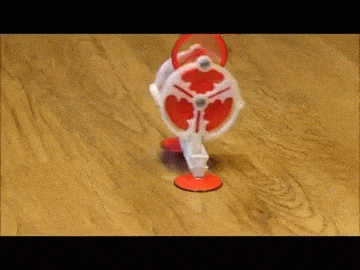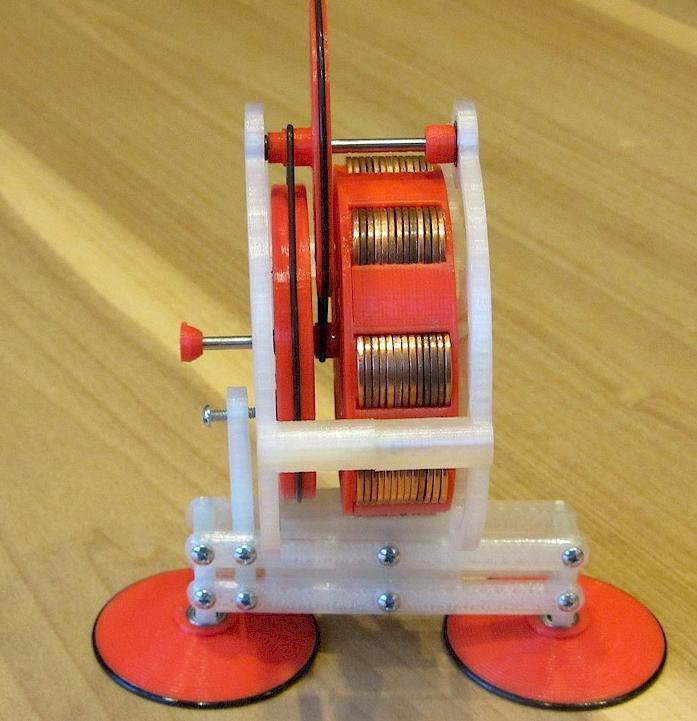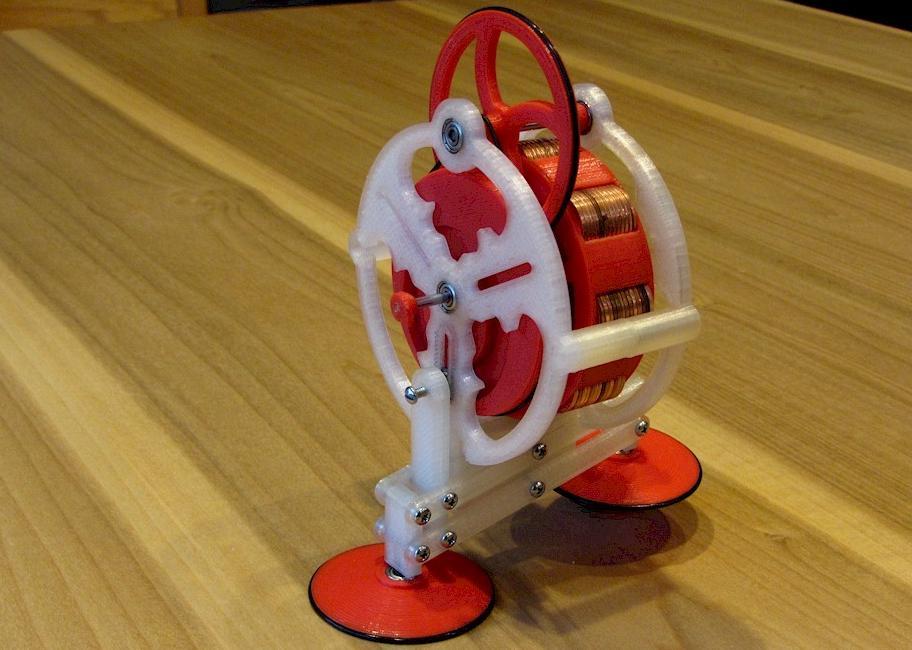Engineer Creates the Gyroman – 3D Printed, Money Filled, Walking Mechanism
 When it comes to 3D printed toys, designers seem to be getting more and more clever by the day. Many individuals have been reverse engineering functional toys that they remember playing with when they were children, while others come up with completely new ideas on their own. For one engineer, named Jeffrey Kerr, he’s owned a 3D printer for about 2 years now.
When it comes to 3D printed toys, designers seem to be getting more and more clever by the day. Many individuals have been reverse engineering functional toys that they remember playing with when they were children, while others come up with completely new ideas on their own. For one engineer, named Jeffrey Kerr, he’s owned a 3D printer for about 2 years now.
Kerr isn’t like your typical designer when it comes to modeling objects for 3D printing. He likes to create functional objects that are actually fun to play with.
“Back when I was an engineering grad student, another student, John Jameson, handed me this strange mechanism he had designed and asked if I could guess what it was,” Kerr explains to 3DPrint.com. “I studied it a bit and got it mostly right (some sort of walking toy) but then he spun it up and it blew me away. That was back in 1981. Since then, I’ve always wanted to make one of my own.”
Thanks to 3D printing this has become a possibility for Kerr, as he has created quite an accurate replica of this 34-year-old toy, called the Gyroman. The device, which mechanically couples a spinning gyroscope to a pair of feet that stomp up and down, also requires 104 pennies be inserted into its body for flywheel mass.
Kerr’s design had to take a few steps backward from the original design, in that the original was way too intricate and featured too many tiny gears and couplings to have had any hope of recreating via 3D printing. It took some redesigning, but he was able to come up with a mechanism that functions just as well.
The first part that he elected to redesign was the gear reductions. It needed about a 50:1 reduction, which Kerr was able to accomplish by using a 2-stage O-ring belt drive.
“O-rings are incredibly forgiving, so 3D printing accuracies work out fine,” Kerr explains to us. “However, they aren’t hugely efficient, and I was worried that they might eat up too much of the flywheel energy. They seem to work OK, though. The second thing that I radically re-designed was the linkage driving the legs. The original used what’s known as a spatial 4-bar mechanism. I opted instead to use a cam-type mechanism. This gave me a nice flat package of parallel discs.”
 The difficult part for Kerr was figuring out the ratios of the flywheel mass, link lengths, and RPM, to actually make the device walk. His friend John Jameson did a lot of math in order to figure out how to make his 1981 model do the same. However, Kerr opted for experimentation alone in order to come up with the correct ratios.
The difficult part for Kerr was figuring out the ratios of the flywheel mass, link lengths, and RPM, to actually make the device walk. His friend John Jameson did a lot of math in order to figure out how to make his 1981 model do the same. However, Kerr opted for experimentation alone in order to come up with the correct ratios.
All of Kerr’s parts were modeled in Solidworks, and printed on a 3D printer with a heated bead, to ensure that there was minimal warping.
“I’m incredibly pleased with how it turned out,” Kerr tells us. “I’ve also shown it to John Jameson. He originally designed this for a Mattel toy contest, which he won, and Mattel then went on to make a prototype toy. In testing, however, while all the adults thought it was fascinating, the kids more or less yawned, viewing it as just another wind-up walking toy. Eventually it did get produced by Tomy (Japan), but it never had a big release in the US. John’s very pleased to see Gyroman walking again, courtesy of 3d printing.”
 Mostly 3D printed, the Gyroman requires about $10 in additional parts. Kerr is still exploring ways to improve the running time, but overall is very satisfied with how the mechanism turned out. For those of you wondering just how this toy actually works, Kerr explains:
Mostly 3D printed, the Gyroman requires about $10 in additional parts. Kerr is still exploring ways to improve the running time, but overall is very satisfied with how the mechanism turned out. For those of you wondering just how this toy actually works, Kerr explains:
“There is a gyroscope spinning at a few thousand RPM, which is geared down to drive a pair of legs that pivot up and down. If you’ve ever played with a toy gyroscope, you know that if you hang it by one end with a string, it doesn’t tip and fall like you’d expect, but it instead stays level and ‘precesses’ around the string. If you hang it from the other end, it precesses in the opposite direction. The walking mechanism makes use of this property. When one foot is down, instead of tipping over, the body stays upright but starts to precess in one direction. When the other foot comes down, the body precesses in the opposite direction, causing it to walk forward.”
Kerr has uploaded the 3D design files and instructions to Thingiverse, making them freely available to anyone who wishes to download and 3D print the Gyroman. What do you think about his design? Discuss in the 3D Printed Gyroman forum thread on 3DPB.com. Check out the video of the Gyroman in action below.
Subscribe to Our Email Newsletter
Stay up-to-date on all the latest news from the 3D printing industry and receive information and offers from third party vendors.
Print Services
You May Also Like
Low-cost “Suzy” Polymer Powder 3D Printer is Faster and Cheaper than Past Models
Polish laser powder bed fusion (LPBF) firm Sinterit has released a follow-up to its predecessors, Lisa and Nils, called Suzy, a $19,490 printer equipped with a 30W fiber diode laser....
India’s $58M Space Fund Is a Boon for AM Innovation
India’s space industry is picking up serious momentum. With a projected $44 billion space economy by 2033, the country is aggressively expanding its capabilities, fostering private-sector participation, and reducing its...
Japanese Advanced Manufacturing Capabilities Grow in Europe with Sodick’s Purchase of Prima Additive
The global economy is currently undergoing a reshuffling in terms of what gets manufactured where. In large part, this trend is being driven by new geopolitical alliances and the need...
Bosch Invests €6M into Serial Auto Part 3D Printing
German industrial conglomerate Robert Bosch GmbH, the world’s largest supplier of automotive parts, has announced a new investment into Nuremberg, Germany additive manufacturing (AM) facility. The nearly €6 million in...




























